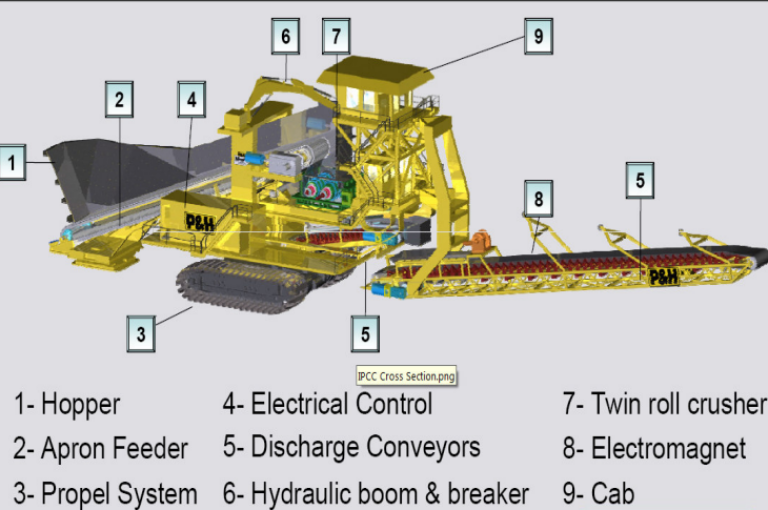Definition
An alternate transport method called in-pit crushing and conveying (IPCC) has a larger initial cost but offers significant operating cost savings. The best technology for big open pit mines with high production is IPCC.
a continuous processing system that breaks down rock of mine (ROM) into a size that can be conveyed, using a shovel, crusher, spreader, and all necessary conveyors. IPCC refers to the process of removing material from an open-pit mine by use of fully mobile, semi-mobile, or stationary in-pit crushers combined with conveyors and spreaders (for waste) or stackers (for ore).
Depending on individual parameters, it can achieve full or partial replacement of trucks for material transport within and out of a mine. If a mine provides two conveyors, both ore and waste are conveyed out of the pit.
By this way, the truck transport on long uphill distance is eliminated. When the mine supplies only one conveyor, it conveys ore and waste on different shifts, or all the waste is transported by trucks to the surface.
The in-pit crusher is moved down every one or two years, to keep the truck haulage to a minimum. The relocation takes 2-3 days. For short moving times the processing plant can be fed from a stockpile.
In longer stoppages, usually in European operations, the move coincides with a general mine holiday period. The crusher is located next to an embankment, so that trucks can dump the material directly from the embankment into the hopper/feeder above the crusher.
Under an alternative arrangement, the crusher is located closer to the centre and has a separate feeder with the feeder tail-end located in the recess in the pit floor. The trucks dump the material from the pit floor into the hopper on the feeder. Belt conveyors can be one of the most efficient means of transporting material out of the pit.
IPCC system advantages
- Energy efficiency – conveying is more efficient than other forms of material transport.
- Mine life, up to 50-60 years of operation – need at least four years to pay back capital and +10 is ideal.
- Material movements – need at least 10 Mt/y (prefer 25 Mt) per stage.
- Electricity cost versus diesel cost – electricity costs ($/kWh) less than 25% of diesel price ($/litre).
- Number of material types – co-disposal makes dump development difficult but not impossible.
IPCC system disadvantages
- The initial cost of system is normally higher than that of the truck haulage system, because the complete conveyor and crusher are bought to start production whereas the truck fleet can be bought in stages to set up production.
- The mining operation is completely dependent on availability of the conveyors. This availability is over 95% but a shutdown of one belt can stop the entire production.
- Relocation of the crusher and extension of the conveyor is expensive and requires a shutdown of the mining operation for a period from 2-3 days.
- Material must be crushed to a size of minus 250 mm before loading onto the conveyor.
- IPCC and shovel do not operate together.
- In-pit crushing required for conveying (hard rock) even if not needed (overburden).
Bibliography
Radlowski, J.K., 1988, In-pit crushing and conveying as an alternative to an all-truck system in open pit mines, The University of British Columbia.
Scot Szalanski, P.E., 2009, Optimizing in-pit crusher conveyor performance, P&H Mining Equipment.
Tavakoli Mohammadi, M. R., Hashemi, S., & Moosakazemi, F. (2011). Review of the in-pit crushing and conveying (IPCC) system and its case study in copper industry.







